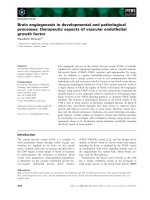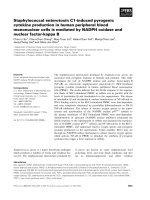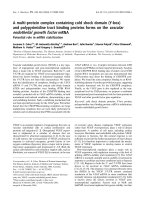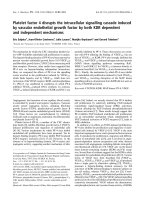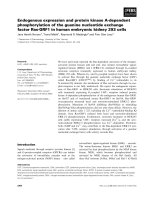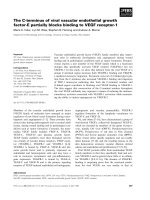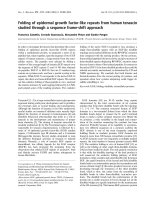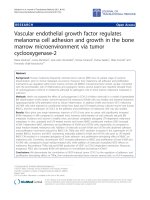hepatocyte growth factor increases vascular endothelial growth factor a production in human synovial fibroblasts through c met receptor pathway
Bạn đang xem bản rút gọn của tài liệu. Xem và tải ngay bản đầy đủ của tài liệu tại đây (700.16 KB, 10 trang )
Hepatocyte Growth Factor Increases Vascular Endothelial
Growth Factor-A Production in Human Synovial
Fibroblasts through c-Met Receptor Pathway
Yu-Min Lin1,2, Yuan-Li Huang3, Yi-Chin Fong4,5, Chun-Hao Tsai4,6, Ming-Chih Chou1, Chih-Hsin Tang7,8*
1 Institute of Medicine, Chung Shan Medical University, Taichung, Taiwan, 2 Department of Orthopedic Surgery, Taichung Veterans General Hospital, Taichung, Taiwan,
3 Department of Biotechnology, College of Health Science, Asia University, Taichung, Taiwan, 4 Department of Orthopaedic Surgery, China Medical University Hospital,
Taichung, Taiwan, 5 School of Chinese Medicine, China Medical University, Taichung, Taiwan, 6 Department of Medicine and Graduate Institute of Clinical Medical Science,
China Medical University, Taichung, Taiwan, 7 Department of Pharmacology, School of Medicine, China Medical University, Taichung, Taiwan, 8 Graduate Institute of Basic
Medical Science, China Medical University, Taichung, Taiwan
Abstract
Background: Angiogenesis is essential for the progression of osteoarthritis (OA). Hepatocyte growth factor (HGF) is an
angiogenic mediator, and it shows elevated levels in regions of OA. However, the relationship between HGF and vascular
endothelial growth factor (VEGF-A) in OA synovial fibroblasts (OASFs) is mostly unknown.
Methodology/Principal Findings: Here we found that stimulation of OASFs with HGF induced concentration- and timedependent increases in VEGF-A expression. Pretreatment with PI3K inhibitor (Ly294002), Akt inhibitor, or mTORC1 inhibitor
(rapamycin) blocked the HGF-induced VEGF-A production. Treatment of cells with HGF also increased PI3K, Akt, and
mTORC1 phosphorylation. Furthermore, HGF increased the stability and activity of HIF-1 protein. Moreover, the use of
pharmacological inhibitors or genetic inhibition revealed that c-Met, PI3K, Akt, and mTORC1 signaling pathways were
potentially required for HGF-induced HIF-1a activation.
Conclusions/Significance: Taken together, our results provide evidence that HGF enhances VEGF-A expression in OASFs by
an HIF-1a-dependent mechanism involving the activation of c-Met/PI3K/Akt and mTORC1 pathways.
Citation: Lin Y-M, Huang Y-L, Fong Y-C, Tsai C-H, Chou M-C, et al. (2012) Hepatocyte Growth Factor Increases Vascular Endothelial Growth Factor-A Production in
Human Synovial Fibroblasts through c-Met Receptor Pathway. PLoS ONE 7(11): e50924. doi:10.1371/journal.pone.0050924
Editor: Kaustubh Datta, University of Nebraska Medical Center, United States of America
Received July 23, 2012; Accepted October 26, 2012; Published November 28, 2012
Copyright: ß 2012 Lin et al. This is an open-access article distributed under the terms of the Creative Commons Attribution License, which permits unrestricted
use, distribution, and reproduction in any medium, provided the original author and source are credited.
Funding: This work was supported by grants from the National Science Council of Taiwan (NSC99-2320-B-039-003-MY3 and NSC100-2320-B-039-028-MY3) and
China Medical University (CMU100-ASIA-07). The funders had no role in study design, data collection and analysis, decision to publish, or preparation of the
manuscript.
Competing Interests: All authors have no financial or personal relationships with other people or organizations that could inappropriately influence their work.
* E-mail:
of certain solid tumors, and ascites formation [6]. Recently several
reports demonstrated that VEGF-A was also implicated in the
pathogenesis of OA [7,8]. Treatment with a soluble form of the
Flt-1 (VEGF-A receptor 1) significantly attenuated disease severity
in arthritis [6,9]. Therefore, anti-angiogenesis may be a novel
therapy for OA treatment.
Hepatocyte growth factor (HGF) was identified in the early
1980s [10,11] and was subsequently determined to be a
heterodimeric molecule composed of an alpha and beta chain
[12]. The importance of HGF in organ development is
demonstrated by HGF null mutation mice, which exhibit
embryonic lethality [13]. HGF exhibits strong angiogenic properties through its ability to induce expression of vascular
endothelial growth factor, another angiogenic factor, but also
has angiogenic properties of its own [14]. Recent studies have
shown that the HGF plays a multifunctional role in OA cartilage
and synovium [15,16]. The complex biological action of HGF is
mediated through the protooncogene c-Met, a transmembrane
tyrosine kinase cell surface receptor, expressed on a multitude of
cells including chondrocytes, synovial fibroblasts, and endothelial
cells [17].
Introduction
Osteoarthritis (OA) is a chronic joint disorder characterized by
slow progressive degeneration of articular cartilage, subchondral
bone alteration, and variable secondary synovial inflammation. In
response to macrophage-derived proinflammatory cytokines such
as interleukin (IL)-1b and tumor necrosis factor-a (TNF-a), OA
synovial fibroblasts (OASFs; the most abundant cells in OA joints)
produce chemokines that promote inflammation, cartilage degradation, and neovascularization via activation of angiogenesis
factors such as vascular endothelial growth factor-A (VEGF-A)
[1,2]. It has been reported that human inflammatory synovial
fibroblasts including: OASF and rheumatoid arthritis (RA) SF
induced angiogenesis through VEGF mediated pathway [3].
Therefore, SF mediated VEGF expression and angiogenesis play
critical roles in the progression of OA and RA.
VEGF-A is a heparin binding, dimeric glycoprotein that induces
the proliferation and migration of endothelial cells to form new
vessels, and increases the penetration and extravagation of plasma
macromolecules [4,5]. VEGF-A has been shown to play an
important role in wound healing, embryonic development, growth
PLOS ONE | www.plosone.org
1
November 2012 | Volume 7 | Issue 11 | e50924
HGF Increases VEGF-A Expression
and 100 mg/ml streptomycin (pH adjusted to 7.6). Fibroblasts
from passages four to nine were used for the experiments [24,25].
Hypoxia-inducible factor (HIF) is a heterodimeric transcription
factor composed of the basic helix-loop-helix-Per-Arnt-Simdomain, containing the proteins HIF-1a and arylhydrocarbon
receptor nuclear translocator (HIF-1b) [18]. The availability of
HIF-1 is determined primarily by HIF-1a, which is regulated at
the protein level in an oxygen-sensitive manner, in contrast to
HIF-1a, which is stably expressed [19,20]. During normoxia, HIF1a is efficiently degraded through the von Hippel-Lindaudependent ubiquitin-proteasome pathway [20]. Under hypoxia,
HIF-1a protein is markedly stabilized, translocates to the nucleus,
and heterodimerizes with HIF-1b. The HIF-1a and HIF-1b
complex can then bind to hypoxia response elements (HREs)
located in gene promoters to regulate transcription of VEGF-A,
erythropoietin, and glycolytic enzymes that enhance cellular
adaptation to hypoxia [21]. Recently, the expression of VEGF-A
via the activation of the phosphoinositide 3-kinase (PI3K), Akt,
and mTORC1 pathway has also been shown to be mediated by
HIF-1a [22,23].
Angiogenesis is essential for the development, growth, and
progression of OA [7]. VEGF-A is a potent angiogenic factor that
is pivotal in the OA pathogenesis. Although a role for HGF in
VEGF-A production has been implicated in some cell types, the
signaling pathway for HGF in VEGF-A production in synovial
fibroblasts has not been extensively studied. In this study, we
explored the intracellular signaling pathway involved in HGFinduced VEGF-A production in human synovial fibroblasts. The
results show that HGF and c-Met interaction activates PI3K, Akt,
mTORC1, and HIF-1a pathways, leading to up-regulation of
VEGF-A expression.
Measurement of VEGF-A Production
Human synovial fibroblasts were cultured in 24-well culture
plates. After reaching confluency, cells were treated with HGF
(30 ng/ml) and then incubated in a humidified incubator at 37uC
for 24 h. To examine the downstream signaling pathways involved
in HGF treatment, cells were pretreated with various inhibitors for
30 min before addition of HGF (30 ng/ml). After incubation, the
medium was removed and stored at 280uC until the assay was
performed. VEGF-A in the medium was assayed using VEGF-A
enzyme immunoassay kits, according to the procedure described
by the manufacturer.
Quantitative Real-time PCR
Total RNA was extracted from synovial fibroblasts with a
TRIzol kit (MDBio Inc., Taipei, Taiwan) and was quantified by
adding 1 ml of sample to 79 ml RNase-free water. The absorbance
was measured in a RNA/DNA calculator (GeneQuant Pro, GE
Healthcare, Piscataway, NJ) at 260 and 280 nm. The reverse
transcription reaction was performed using 2 mg of total RNA (in
2 ml RNase-free water) that was reverse transcribed into cDNA
with an MMLV RT kit (Promega, Madison, WI) following the
manufacturer’s recommended procedures [26,27]. The reverse
transcription reaction mixture was incubated at 37uC for 60 min
and then at 70uC for 5 min to inactivate MMLV. Quantitative
real time PCR (qPCR) analysis was carried out with TaqManH
one-step PCR Master Mix (Applied Biosystems, Foster City, CA).
cDNA template (2 ml) was added to each 25-ml reaction with
sequence-specific primers and TaqManH probes. All target gene
primers and probes were purchased commercially (b-actin was
used as internal control) (Applied Biosystems). qPCR assays were
carried out in triplicate on a StepOnePlus sequence detection
system. The cycling conditions were: 10-min polymerase activation at 95uC followed by 40 cycles at 95uC for 15 s and 60uC for
60 s. The threshold was set above the non-template control
background and within the linear phase of target gene amplification to calculate the cycle number at which the transcript was
detected (denoted CT). Reactions were normalized to copies of bactin mRNA within the same sample using the 2DDCT method.
The levels of mRNA are expressed as the fold change in expression
level compared with that of controls.
Materials and Methods
Materials
Anti-mouse and anti-rabbit IgG-conjugated horseradish peroxidase, rabbit polyclonal antibodies specific for b-actin, PCNA, cMet, p-p85a(Tyr467), p85a, p-Akt1(Ser473), Akt1, p-mTORC1(Ser2448), mTORC1, p-S6K(Thr389), HIF-1a, HIF-1b, and the
small interfering RNAs (siRNAs) against c-Met, mTORC1, and a
control for experiments using targeted siRNA transfection (each
consisting of a scrambled sequence that does not lead to specific
degradation of any known cellular mRNA) were purchased from
Santa Cruz Biotechnology (Santa Cruz, CA). The recombinant
human HGF and VEGF-A enzyme immunoassay kit were
purchased from R&D Systems (Minneapolis, MN, USA). The
p85a and Akt (Akt K179A) dominant negative mutant and pHREluciferase construct were gifts from Dr. W.M. Fu (National Taiwan
University, Taipei, Taiwan). The pSV-b-galactosidase vector and
luciferase assay kit were purchased from Promega (Madison, WI).
All other chemicals were obtained from Sigma-Aldrich (St. Louis,
MO).
Western Blot Analysis
Cellular lysates were prepared as described [28,29]. Proteins
were resolved using SDS-PAGE and transferred to Immobilon
polyvinyldifluoride membranes. The membranes were blocked
with 4% BSA for 1 h at room temperature and then probed with
rabbit antibodies against human p-p85, p85, p-Akt, Akt, pmTORC1, or mTORC1 (1:1000) for 1 h at room temperature.
After three washes, the blots were incubated with a donkey antirabbit peroxidase-conjugated secondary antibody (1:1000) for 1 h
at room temperature. The blots were visualized with enhanced
chemiluminescence on Kodak X-OMAT LS film (Eastman
Kodak, Rochester, NY).
Cell Cultures
The study protocol was approved by the Institutional Review
Board of China Medical University Hospital, and all subjects gave
informed written consent before enrollment in this study. Human
synovial fibroblasts were isolated using collagenase treatment of
synovial tissues obtained from knee replacement surgeries of 33
patients with OA. Fresh synovial tissues were minced and digested
in a solution of collagenase and DNase. Isolated fibroblasts were
filtered through 70-mm nylon filters. The cells were grown on
plastic cell culture dishes in 95% air/5% CO2 in RPMI 1640 (Life
Technologies) that was supplemented with 20 mM of HEPES and
10% heat-inactivated FBS, 2 mM glutamine, 100 U/ml penicillin,
PLOS ONE | www.plosone.org
Transfection and Reporter Gene Assay
Human synovial fibroblasts were co-transfected with 0.8 mg
HRE luciferase plasmid and 0.4 mg b-galactosidase expression
vector. OASFs were grown to 80% confluency in 12-well plates
and then transfected on the following day with Lipofectamine
2000 (LF2000; Invitrogen). DNA and LF2000 were premixed for
2
November 2012 | Volume 7 | Issue 11 | e50924
HGF Increases VEGF-A Expression
Figure 1. HGF stimulates concentration- and time-dependent increases in VEGF-A production. OASFs were incubated with HGF (3–
100 ng/ml) for 24 h (A) or with HGF (30 ng/ml) for 6, 12, or 24 h (B), and VEGF-A mRNA was examined by qPCR. (C–F) OASFs were incubated with
HGF (3–100 ng/ml) for 24 h or with HGF (30 ng/ml) for 6, 12, or 24 h, and VEGF-A protein expression was examined by Western blotting (whole cells
lysate) and ELISA (medium). Results are expressed as the mean 6 S.E. *, p,0.05 compared with control; #, p,0.05 compared with HGF-treated
group.
doi:10.1371/journal.pone.0050924.g001
value of luciferase activity was normalized to the transfection
efficiency, which was monitored by activity of the co-transfected bgalactosidase expression vector.
20 min and then added to the cells. After 24 h of transfection, the
cells were incubated with the indicated reagents. After a further
24 h of incubation, the medium was removed, and cells were
washed once with cold PBS. To prepare lysates, 100 ml reporter
lysis buffer (Promega, Madison, WI) was added to each well, and
cells were scraped from dishes. The supernatant was collected after
centrifugation at 13,000 rpm for 2 min. Aliquots of cell lysates
(20 ml) containing equal amounts of protein (20–30 mg) were
placed into wells of an opaque black 96-well microplate. An equal
volume of luciferase substrate was added to all samples, and
luminescence was measured in a microplate luminometer. The
PLOS ONE | www.plosone.org
Statistics
The values reported are means 6 S.E. Statistical comparisons
between two samples were performed using Student’s t-test.
Statistical comparisons of more than two groups were performed
using one-way analysis of variance (ANOVA) with Bonferroni’s
post-hoc test. In all cases, p,0.05 was considered significant.
3
November 2012 | Volume 7 | Issue 11 | e50924
HGF Increases VEGF-A Expression
Figure 2. The c-Met receptor is involved in HGF-mediated VEGF-A production. (A) OASFs were transfected with c-Met siRNA for 24 h, and
c-Met expression was examined by Western blotting. (B–D) OASFs were pretreated with the c-Met inhibitor (3 mM) for 30 min or transfected with cMet siRNA for 24 h followed by treatment with HGF for 24 h, the VEGF-A expression was examined by qPCR, Western blotting, and ELISA. Results are
expressed as the mean 6 S.E. *, p,0.05 compared with control; #, p,0.05 compared with HGF-treated group.
doi:10.1371/journal.pone.0050924.g002
Results
HGF Increases VEGF-A Production via the c-Met Receptor
It has been reported that HGF exerts its effects through
interaction with a specific receptor c-Met [30]. Next, we examine
whether c-Met receptor is involved in HGF-mediated VEGF-A
production in human synovial fibroblasts. Transfection of cells
with c-Met siRNA reduced c-Met expression in OASFs (Fig. 2A).
In addition, transfection of OASFs with c-Met siRNA blocked
HGF-increased VEGF-A production (Fig. 2B&C). Furthermore, cMet inhibitor also inhibited HGF-induced VEGF-A up-regulation
(Fig. 2B–D). Therefore, an interaction between HGF and c-Met is
very important for VEGF-A production in OASFs.
HGF Induces VEGF-A Production in Human Synovial
Fibroblasts
The typical pathology of OA includes chronic inflammation of
the synovium that is characterized by infiltration of inflammatory
cells and synovial hyperplasia, especially of fibroblast-like synoviocytes. Therefore, we used human synovial fibroblasts to
investigate the signaling pathways of HGF in the production of
VEGF-A. Treatment of OASFs with HGF (3–100 ng/ml) for 24 h
induced VEGF-A mRNA expression in a concentration-dependent manner (Fig. 1A), and this induction occurred in a timedependent manner (Fig. 1B). In addition, stimulation of cells with
VEGF-A also led to increased expression of VEGF-A protein in a
concentration and time-dependent manner as shown by Western
blotting and ELISA assay (Fig. 1C–F). These data suggest
suggesting that the HGF increased VEGF-A expression is human
synovial fibroblasts.
PLOS ONE | www.plosone.org
The PI3K, Akt, and mTORC1 Signaling Pathways are
Involved in the Potentiating Action of HGF
PI3K-dependent Akt activation has been reported to regulate
VEGF-A expression [31]. We next examined whether HGF
stimulation also enhances PI3K/Akt activation. First, we directly
measured phosphorylation of p85 in response to HGF. Stimulation of OASFs led to a significant increase in phosphorylation of
p85 (Fig. 3A). Pretreatment of cells with PI3K inhibitor Ly294002
4
November 2012 | Volume 7 | Issue 11 | e50924
HGF Increases VEGF-A Expression
Figure 3. The PI3K/Akt signaling pathway is activated in response to HGF treatment of synovial fibroblasts. (A) OASFs were incubated
with HGF for indicated time intervals, and p85 and Akt phosphorylation was examined by Western blotting. (B–D) OASFs were pretreated for 30 min
with Ly294002 (10 mM) or Akt inhibitor (10 mM) followed by treatment with HGF for 24 h, the VEGF-A expression was examined by qPCR, Western
blotting, and ELISA. (E) OASFs were transfected with p85 or Akt mutant followed by stimulation with HGF for 24 h, the VEGF-A expression was
examined by ELISA. OASFs were pretreated for 30 min with c-Met inhibitor (F) or c-Met inhibitor and Ly294002 for 30 min (G) followed by stimulation
with HGF for 15 min, and p85 and Akt phosphorylation was determined by Western blotting. Results are expressed as the mean 6 S.E. *, p,0.05
compared with control; #, p,0.05 compared with HGF-treated group.
doi:10.1371/journal.pone.0050924.g003
PLOS ONE | www.plosone.org
5
November 2012 | Volume 7 | Issue 11 | e50924
HGF Increases VEGF-A Expression
Figure 4. mTORC1 activation is involved in HGF-mediated VEGF-A production. (A) OASFs were incubated with HGF for indicated time
intervals, mTORC1 and S6K phosphorylation was examined by Western blotting. (B–D) OASFs were pretreated for 30 min with rapamycin (30 nM)
followed by treatment with HGF for 24 h, the VEGF-A expression was examined by qPCR, Western blotting, and ELISA. (E) OASFs were transfected
with mTORC1 siRNA followed by stimulation with HGF for 24 h, the VEGF-A expression was examined by ELISA. (F) OASFs were pretreated for 30 min
with c-Met inhibitor, Ly294002, and Akt inhibitor for 30 min, followed by stimulation with HGF for 30 min, and mTORC1 phosphorylation was
determined by Western blotting. Results are expressed as the mean 6 S.E. *, p,0.05 compared with control; #, p,0.05 compared with HGF-treated
group.
doi:10.1371/journal.pone.0050924.g004
VEGF-A expression, we next determined Akt Ser473 phosphorylation in response to HGF treatment. As shown in Figure 3A,
treatment of OASFs with HGF resulted in time-dependent
phosphorylation of Akt Ser473. Pretreatment of cells with Akt
inhibitor or transfection of cells with Akt mutant antagonized
reduced HGF-increased VEGF-A production (Fig. 3B–D). Transfection with p85 mutant also reduced HGF-induced VEGF-A
expression (Fig. 3E). Pretreatment of cells with c-Met inhibitor
reduced HGF-mediated p85 phosphorylation (Fig. 3F). To
examine the crucial role of PI3K-dependent Akt in HGF-induced
PLOS ONE | www.plosone.org
6
November 2012 | Volume 7 | Issue 11 | e50924
HGF Increases VEGF-A Expression
Figure 5. HGF enhances HIF-1a activation. (A) OASFs were incubated with HGF for indicated time intervals, and HIF-1a expression was
examined by Western blotting. (B) OASFs were incubated with HGF for indicated time intervals, and nucleus HIF-1a accumulation was determent by
Western blotting. (C) OASFs were incubated with HGF for indicated time intervals, and HIF-1a mRNA expression was examined by qPCR. (D&E) OASFs
were pretreated for 30 min with HIF-1a inhibitor followed by treatment with HGF for 24 h, the VEGF-A expression was examined by qPCR and ELISA.
(F) OASFs were transfected with HIF-1a mutant followed by stimulation with HGF for 24 h, the VEGF-A expression was examined by ELISA. Results are
expressed as the mean 6 S.E. *, p,0.05 compared with control; #, p,0.05 compared with HGF-treated group.
doi:10.1371/journal.pone.0050924.g005
HGF-induced VEGF-A expression (Fig. 3B–E). In addition,
pretreatment of cells with c-Met inhibitor or Ly294002 reduced
HGF-mediated Akt phosphorylation (Fig. 3G). Taken together,
these results indicate that the PI3K/Akt pathway is involved in
HGF-induced VEGF-A production.
PLOS ONE | www.plosone.org
Because the PI3K/Akt pathway is a major upstream activator of
mTORC1, we next measured mTORC1 activation in response
HGF treatment. Treatment of OASFs with HGF resulted in timedependent phosphorylation of mTORC1 (Fig. 4A). Ribosomal S6
kinase (S6K) is major target of mTORC1 signaling. Treatment of
OASFs with HGF also increased S6K phosphorylation (Fig. 4A).
7
November 2012 | Volume 7 | Issue 11 | e50924
HGF Increases VEGF-A Expression
Nuclear translocation of HIF-1a is necessary for its transcriptional
activation of a variety of HIF-1-regulated genes [33]. We therefore
used Western blotting to examine the nuclear translocation of
HIF-1a protein in OASFs after HGF treatment. As shown in
Fig. 5B, HGF stimulation enhanced the accumulation of HIF-1a
in the nucleus in a time-dependent manner. Based on the above
findings, we suggest that HGF increased the stability of HIF
protein and thus the nuclear HIF-1 binding activity of HRE. We
then examined whether HGF could up-regulated HIF-1a protein
in OASFs via the increase of mRNA level. We found that HGF
did not affect the mRNA level of HIF-1a (Fig. 5C). Pretreatment
of cells with HIF-1a inhibitor antagonized HGF-increased VEGFA production (Fig. 5D&E). In addition, the expression of VEGF-A
for HGF-treated cells was found to decrease markedly after
transfection with the dominant-negative mutant HIF-1a (Fig. 5F)
carrying both of the deletions of the basic DNA binding domain
(amino acids 4–27) and the carboxyl-terminal transactivation
domain (amino acids 390–826), thus effectively inhibiting HIF-1a
activity [34]. Based on these findings, we suggest that HGF
enhances the stabilization and DNA binding activity of HIF-1a.
HGF-induced HIF-1 Activation and Subsequent VEGF-A
Expression via c-Met, PI3K, Akt, and mTORC1 Pathways
We further explored whether c-Met, PI3K, Akt, and mTORC1
pathways were involved in the HGF-induced HIF-1a activation in
the cultured OASFs. The HGF mediated increase of HRE
promoter activity was inhibited by c-Met inhibitor, Ly294002, Akt
inhibitor, and rapamycin (Fig. 6A) or c-Met and mTORC1 siRNA
or p85 and Akt mutant (Fig. 6B). Therefore, c-Met, PI3K, Akt,
and, mTORC1 signaling pathways are involved in HGF-mediated
HIF-1a activation.
Discussion
OA is a heterogeneous group of conditions associated with
defective integrity of articular cartilage as well as related changes
in the underlying bone. Neovascularization, the formation of new
blood vessels, can maintain the chronic inflammatory status by
transporting the inflammatory cells to the site of synovitis as well as
supplying nutrients and oxygen to pannus [35,36]. VEGF-A is a
major angiogenic factor in OA joints [37]. In addition, HGF plays
important role during OA pathogenesis. However, the effect of
HGF on VEGF-A expression in human synovial fibroblasts is
mostly unknown. Here, we found VEGF-A as a target protein for
the HGF signaling pathway that regulates the neovascularization.
We showed that potentiation of VEGF-A by HGF requires
activation of the c-Met, PI3K, Akt, mTORC1, and HIF-1a
signaling pathways.
PI3K may possibly regulated the cell function by promoting the
phosphorylation of Akt on Ser473 and its downstream pathways of
mTORC1 [38]. Our results demonstrated that pretreatment of
OASFs with PI3K, Akt, or an mTORC1 inhibitor antagonized
the HGF-induced increase of VEGF expression. On the other
hand, HGF treatment increased the level of mTORC1 phosphorylation. This effect was inhibited by Ly294002 and Akt inhibitor,
indicating the involvement of PI3K/Akt-dependent mTORC1
activation in HGF-mediated VEGF expression. In addition to
VEGF expression and angiogenesis, a similar signaling pathway
has also been reported in N-myc induced VEGF expression and
angiogenesis in neuroblastoma, which involved PI3K-dependent
Akt, and mTORC1 activation [39]. Regulation of angiogenesis
and tumor growth by hispidulin is also related to PI3K/Akt/
mTORC1 signal cascade [40]. Notoginsenoside Ft1 promoted
VEGF expression and angiogenesis, which involved PI3K/Akt,
Figure 6. The c-Met/PI3K/Akt/mTORC1 signaling pathway is
involved in the increase of HIF-1a activity in response to HGF.
OASFs were pretreated with c-Met inhibitor, Ly294002, Akt inhibitor,
and rapamycin for 30 min (A) or co-transfected with c-Met and mTORC1
siRNA or p85 and Akt mutant (B) before exposure to HGF. HRE luciferase
activity was measured 24 h after HGF treatment, and the results were
normalized to the b-galactosidase activity and expressed as the mean 6
S.E. for three independent experiments performed in triplicate. Results
are expressed as the mean 6 S.E. *, p,0.05 compared with control; #,
p,0.05 compared with HGF-treated group.
doi:10.1371/journal.pone.0050924.g006
On the other hand, pretreatment of cells with mTORC1 inhibitor
rapamycin or transfection of cells with mTORC1 siRNA reduced
HGF-induced VEGF-A expression (Fig. 4B–E). In addition,
incubation of cells with c-Met inhibitor, Ly294002, and Akt
inhibitor also reduced HGF-mediated mTORC1 phosphorylation
(Fig. 4F). Based on these results, it appears that the HGF acted
through the c-Met/PI3K/Akt/mTORC1 signaling pathway to
enhance VEGF-A production in human synovial fibroblasts.
HGF Promotes HIF-1 Activation
HIF, a pivotal transcription factor, is a dominant regulator of
VEGF-A expression [32]. We therefore sought to determine
whether HIF was involved in HGF-induced VEGF-A expression
in the OASFs. To this end, cells were treated with HGF, and the
cell lysates were collected at different time intervals. The results
from Western blotting indicated that HGF significantly increased
protein level of HIF-1a but not HIF-1b time-dependently (Fig. 5A).
PLOS ONE | www.plosone.org
8
November 2012 | Volume 7 | Issue 11 | e50924
HGF Increases VEGF-A Expression
Factors that increase the expression of VEGF have been
suggested as potential therapeutic targets to delay or reduce the
joint destruction that occurs in arthritis patients [45]. Based on the
in vitro effect of HGF on VEGF expression, HGF may be a
potential target for blockage of VEGF expression. However,
further studies are needed to better understand the factors that
control the expression of VEGF in the joint fluid of OA patients.
This knowledge may open new doors to treatment and lead to the
inhibition of the pathological processes of OA.
In conclusion, we explored the signaling pathway involved in
HGF-induced VEGF-A expression in human synovial fibroblasts
and found that HGF increased VEGF-A expression through c-Met
receptor and activation of PI3K, Akt, mTORC1, and HIF-1a
pathways in OASF. These findings may provide a better
understanding of the mechanisms of OA pathogenesis.
and mTORC1 transactivation [41]. Taken together, these results
show that the PI3K/Akt/mTORC1 may be a common route for
VEGF expression and angiogenesis.
HIF-1 is thought to play a major role in VEGF-A expression
[32]. HIF-1a has been reported to activate VEGF-A expression by
binding to the HRE site within the VEGF-A promoter in response
to hypoxia [42]. Likewise, the activation of HIF-1a by HGF also
resulted in an induction of VEGF-A transcription activity through
the HRE site in OASFs, although many other possible response
elements, including activator protein-2, nuclear factor-kB, and
simian virus 40 promoter factor 1, are located within the VEGF
promoter. In this study, HIF-1a inhibitor and mutant complete
blocked HGF-mediated VEGF expression. OASFs up-regulate
HIF-1a after HGF treatment in a time-dependent manner. It is
apparent that HGF-induced VEGF-A expression is substantially
mediated by the HRE. This is not the first study to provide
evidence that HGF is increased through HIF-1a transactivation.
In the hepatoma cells, HGF promoted gene expression by
increasing HIF activity [43], and in the HGF-induced survival
in carcinoma cells, involved HIF-1a activation [44]. In concert
with our study, other studies would seem to suggest that HGF may
mediate HIF-1a activation in many gene expressions and cell
functions. However, we still cannot rule out the effects of other
transcription factors in HGF-induced VEGF-A production in
OASFs.
Acknowledgments
We thank Dr. W. M. Fu for providing p85 and Akt mutants and HREluciferase plasmid.
Author Contributions
Conceived and designed the experiments: C-H Tang. Performed the
experiments: YML YLH. Analyzed the data: YML YLH YCF C-H Tsai.
Contributed reagents/materials/analysis tools: YCF C-H Tsai. Wrote the
paper: YML MCC C-H Tang.
References
1. Mor A, Abramson SB, Pillinger MH (2005) The fibroblast-like synovial cell in
rheumatoid arthritis: a key player in inflammation and joint destruction. Clin
Immunol 115: 118–128.
2. Shen PC, Wu CL, Jou IM, Lee CH, Juan HY, et al. (2011) T helper cells
promote disease progression of osteoarthritis by inducing macrophage
inflammatory protein-1gamma. Osteoarthritis and cartilage/OARS, Osteoarthritis Research Society 19: 728–736.
3. del Rey MJ, Izquierdo E, Caja S, Usategui A, Santiago B, et al. (2009) Human
inflammatory synovial fibroblasts induce enhanced myeloid cell recruitment and
angiogenesis through a hypoxia-inducible transcription factor 1alpha/vascular
endothelial growth factor-mediated pathway in immunodeficient mice. Arthritis
and rheumatism 60: 2926–2934.
4. Dvorak HF, Brown LF, Detmar M, Dvorak AM (1995) Vascular permeability
factor/vascular endothelial growth factor, microvascular hyperpermeability, and
angiogenesis. The American journal of pathology 146: 1029–1039.
5. Chien MH, Ku CC, Johansson G, Chen MW, Hsiao M, et al. (2009) Vascular
endothelial growth factor-C (VEGF-C) promotes angiogenesis by induction of
COX-2 in leukemic cells via the VEGF-R3/JNK/AP-1 pathway. Carcinogenesis 30: 2005–2013.
6. Keating AM, Jacobs DS (2011) Anti-VEGF Treatment of Corneal Neovascularization. The ocular surface 9: 227–237.
7. Ashraf S, Walsh DA (2008) Angiogenesis in osteoarthritis. Current opinion in
rheumatology 20: 573–580.
8. Yamairi F, Utsumi H, Ono Y, Komorita N, Tanaka M, et al. (2011) Expression
of vascular endothelial growth factor (VEGF) associated with histopathological
changes in rodent models of osteoarthritis. Journal of toxicologic pathology 24:
137–142.
9. Miotla J, Maciewicz R, Kendrew J, Feldmann M, Paleolog E (2000) Treatment
with soluble VEGF receptor reduces disease severity in murine collagen-induced
arthritis. Laboratory investigation; a journal of technical methods and pathology
80: 1195–1205.
10. Nakamura T, Nawa K, Ichihara A (1984) Partial purification and characterization of hepatocyte growth factor from serum of hepatectomized rats.
Biochemical and biophysical research communications 122: 1450–1459.
11. Luetteke NC, Michalopoulos GK (1985) Partial purification and characterization of a hepatocyte growth factor produced by rat hepatocellular carcinoma
cells. Cancer research 45: 6331–6337.
12. Funakoshi H, Nakamura T (2003) Hepatocyte growth factor: from diagnosis to
clinical applications. Clinica chimica acta; international journal of clinical
chemistry 327: 1–23.
13. Sengupta S, Gherardi E, Sellers LA, Wood JM, Sasisekharan R, et al. (2003)
Hepatocyte growth factor/scatter factor can induce angiogenesis independently
of vascular endothelial growth factor. Arteriosclerosis, thrombosis, and vascular
biology 23: 69–75.
14. Montesano R, Matsumoto K, Nakamura T, Orci L (1991) Identification of a
fibroblast-derived epithelial morphogen as hepatocyte growth factor. Cell 67:
901–908.
PLOS ONE | www.plosone.org
15. Pfander D, Cramer T, Weseloh G, Pullig O, Schuppan D, et al. (1999)
Hepatocyte growth factor in human osteoarthritic cartilage. Osteoarthritis and
cartilage/OARS, Osteoarthritis Research Society 7: 548–559.
16. Reboul P, Pelletier JP, Tardif G, Benderdour M, Ranger P, et al. (2001)
Hepatocyte growth factor induction of collagenase 3 production in human
osteoarthritic cartilage: involvement of the stress-activated protein kinase/c-Jun
N-terminal kinase pathway and a sensitive p38 mitogen-activated protein kinase
inhibitor cascade. Arthritis and rheumatism 44: 73–84.
17. Nagashima M, Hasegawa J, Kato K, Yamazaki J, Nishigai K, et al. (2001)
Hepatocyte growth factor (HGF), HGF activator, and c-Met in synovial tissues
in rheumatoid arthritis and osteoarthritis. The Journal of rheumatology 28:
1772–1778.
18. Wang GL, Jiang BH, Rue EA, Semenza GL (1995) Hypoxia-inducible factor 1 is
a basic-helix-loop-helix-PAS heterodimer regulated by cellular O2 tension. Proc
Natl Acad Sci U S A 92: 5510–5514.
19. Maxwell PH, Wiesener MS, Chang GW, Clifford SC, Vaux EC, et al. (1999)
The tumour suppressor protein VHL targets hypoxia-inducible factors for
oxygen-dependent proteolysis. Nature 399: 271–275.
20. Salceda S, Caro J (1997) Hypoxia-inducible factor 1alpha (HIF-1alpha) protein
is rapidly degraded by the ubiquitin-proteasome system under normoxic
conditions. Its stabilization by hypoxia depends on redox-induced changes.
J Biol Chem 272: 22642–22647.
21. Sharp FR, Bernaudin M (2004) HIF1 and oxygen sensing in the brain. Nat Rev
Neurosci 5: 437–448.
22. Tseng WP, Yang SN, Lai CH, Tang CH (2010) Hypoxia induces BMP-2
expression via ILK, Akt, mTOR, and HIF-1 pathways in osteoblasts. Journal of
cellular physiology 223: 810–818.
23. Karar J, Maity A (2011) PI3K/AKT/mTOR Pathway in Angiogenesis.
Frontiers in molecular neuroscience 4: 51.
24. Chiu YC, Lin CY, Chen CP, Huang KC, Tong KM, et al. (2009) Peptidoglycan
enhances IL-6 production in human synovial fibroblasts via TLR2 receptor,
focal adhesion kinase, Akt, and AP-1- dependent pathway. Journal of
immunology 183: 2785–2792.
25. Tang CH, Hsu CJ, Fong YC (2010) The CCL5/CCR5 axis promotes
interleukin-6 production in human synovial fibroblasts. Arthritis and rheumatism 62: 3615–3624.
26. Hsieh MT, Hsieh CL, Lin LW, Wu CR, Huang GS (2003) Differential gene
expression of scopolamine-treated rat hippocampus-application of cDNA
microarray technology. Life sciences 73: 1007–1016.
27. Wang YC, Lee PJ, Shih CM, Chen HY, Lee CC, et al. (2003) Damage
formation and repair efficiency in the p53 gene of cell lines and blood
lymphocytes assayed by multiplex long quantitative polymerase chain reaction.
Analytical biochemistry 319: 206–215.
28. Huang HC, Shi GY, Jiang SJ, Shi CS, Wu CM, et al. (2003) Thrombomodulinmediated cell adhesion: involvement of its lectin-like domain. The Journal of
biological chemistry 278: 46750–46759.
9
November 2012 | Volume 7 | Issue 11 | e50924
HGF Increases VEGF-A Expression
38. Sheppard K, Kinross KM, Solomon B, Pearson RB, Phillips WA (2012)
Targeting PI3 kinase/AKT/mTOR signaling in cancer. Critical reviews in
oncogenesis 17: 69–95.
39. Kang J, Rychahou PG, Ishola TA, Mourot JM, Evers BM, et al. (2008) N-myc is
a novel regulator of PI3K-mediated VEGF expression in neuroblastoma.
Oncogene 27: 3999–4007.
40. He L, Wu Y, Lin L, Wang J, Chen Y, et al. (2011) Hispidulin, a small flavonoid
molecule, suppresses the angiogenesis and growth of human pancreatic cancer
by targeting vascular endothelial growth factor receptor 2-mediated PI3K/Akt/
mTOR signaling pathway. Cancer science 102: 219–225.
41. Shen K, Ji L, Gong C, Ma Y, Yang L, et al. (2012) Notoginsenoside Ft1
promotes angiogenesis via HIF-1alpha mediated VEGF secretion and the
regulation of PI3K/AKT and Raf/MEK/ERK signaling pathways. Biochemical pharmacology 84: 784–792.
42. Shima DT, Kuroki M, Deutsch U, Ng YS, Adamis AP, et al. (1996) The mouse
gene for vascular endothelial growth factor. Genomic structure, definition of the
transcriptional unit, and characterization of transcriptional and post-transcriptional regulatory sequences. The Journal of biological chemistry 271: 3877–
3883.
43. Tacchini L, Matteucci E, De Ponti C, Desiderio MA (2003) Hepatocyte growth
factor signaling regulates transactivation of genes belonging to the plasminogen
activation system via hypoxia inducible factor-1. Experimental cell research 290:
391–401.
44. Tacchini L, De Ponti C, Matteucci E, Follis R, Desiderio MA (2004) Hepatocyte
growth factor-activated NF-kappaB regulates HIF-1 activity and ODC
expression, implicated in survival, differently in different carcinoma cell lines.
Carcinogenesis 25: 2089–2100.
45. Pandya NM, Dhalla NS, Santani DD (2006) Angiogenesis–a new target for
future therapy. Vascular pharmacology 44: 265–274.
29. Tseng CP, Huang CL, Huang CH, Cheng JC, Stern A, et al. (2003) Disabled-2
small interfering RNA modulates cellular adhesive function and MAPK activity
during megakaryocytic differentiation of K562 cells. FEBS letters 541: 21–27.
30. Mahtouk K, Tjin EP, Spaargaren M, Pals ST (2010) The HGF/MET pathway
as target for the treatment of multiple myeloma and B-cell lymphomas.
Biochimica et biophysica acta 1806: 208–219.
31. Li W, Wang H, Kuang CY, Zhu JK, Yu Y, et al. (2012) An essential role for the
Id1/PI3K/Akt/NFkB/survivin signalling pathway in promoting the proliferation of endothelial progenitor cells in vitro. Molecular and cellular biochemistry
363: 135–145.
32. Ahluwalia A, Tarnawski AS (2012) Critical role of hypoxia sensor–HIF-1alpha
in VEGF gene activation. Implications for angiogenesis and tissue injury healing.
Current medicinal chemistry 19: 90–97.
33. Lu DY, Liou HC, Tang CH, Fu WM (2006) Hypoxia-induced iNOS expression
in microglia is regulated by the PI3-kinase/Akt/mTOR signaling pathway and
activation of hypoxia inducible factor-1alpha. Biochem Pharmacol 72: 992–
1000.
34. Jiang BH, Jiang G, Zheng JZ, Lu Z, Hunter T, et al. (2001) Phosphatidylinositol
3-kinase signaling controls levels of hypoxia-inducible factor 1. Cell Growth
Differ 12: 363–369.
35. Bonnet CS, Walsh DA (2005) Osteoarthritis, angiogenesis and inflammation.
Rheumatology 44: 7–16.
36. Su JL, Yen CJ, Chen PS, Chuang SE, Hong CC, et al. (2007) The role of the
VEGF-C/VEGFR-3 axis in cancer progression. British journal of cancer 96:
541–545.
37. Haywood L, McWilliams DF, Pearson CI, Gill SE, Ganesan A, et al. (2003)
Inflammation and angiogenesis in osteoarthritis. Arthritis and rheumatism 48:
2173–2177.
PLOS ONE | www.plosone.org
10
November 2012 | Volume 7 | Issue 11 | e50924
